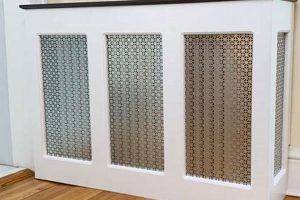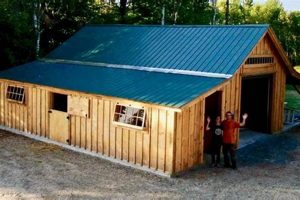The term refers to the practice of installing paving stones by oneself, without professional assistance. This often involves tasks such as site preparation, base material installation, laying the stones, and applying joint sand. The outcome is a paved area, typically a patio, walkway, or driveway, constructed through individual effort.
Undertaking such a project offers several advantages, including cost savings on labor, increased control over design and materials, and the personal satisfaction of completing a home improvement endeavor. Historically, paving has been a labor-intensive task, but readily available materials and instructional resources have made it increasingly accessible to homeowners seeking to enhance their property. The rise in popularity reflects a broader trend towards self-sufficiency and home personalization.
The following sections will delve into key considerations for successfully completing such a project, including material selection, essential tools, site preparation techniques, laying patterns, and proper maintenance procedures, providing a comprehensive guide for achieving a durable and aesthetically pleasing result.
Tips for Successful Paver Installation
Achieving a professional-looking and long-lasting paver installation requires careful planning and execution. Adherence to established best practices is crucial.
Tip 1: Proper Base Preparation: The base is paramount. Excavate to the appropriate depth, typically 6-8 inches for walkways and patios, and compact the subgrade thoroughly. Use a plate compactor to ensure a stable foundation. Inadequate compaction leads to settling and uneven surfaces.
Tip 2: Geotextile Fabric Application: Install geotextile fabric between the subgrade and the base material. This fabric prevents the base material from mixing with the soil below, improving drainage and preventing shifting. Overlap seams by at least 12 inches.
Tip 3: Accurate Slope Establishment: Ensure proper drainage by establishing a slight slope (approximately 1/8 inch per foot) away from structures. Consistent slope prevents water from pooling on the surface and causing damage over time.
Tip 4: Edge Restraint Implementation: Utilize appropriate edge restraints, such as plastic or concrete edging, to contain the pavers and prevent lateral movement. Secure the restraints with spikes every 12 inches, ensuring they are flush with the paver surface.
Tip 5: Consistent Joint Sand Application: Use polymeric sand to fill the joints between pavers. Polymeric sand hardens when activated with water, providing a stable, weed-resistant surface. Follow the manufacturer’s instructions carefully to avoid staining the pavers.
Tip 6: Regular Compaction During Installation: Compact the pavers periodically during installation with a plate compactor and a protective rubber mat. This embeds the pavers into the bedding layer and ensures a level surface.
Tip 7: Careful Cutting Techniques: When cutting pavers to fit irregular spaces, use a paver splitter or a wet saw with a diamond blade. Precise cuts are essential for a clean, professional finish. Always wear appropriate safety gear, including eye and ear protection.
Implementing these strategies will enhance the stability, longevity, and aesthetic appeal of the paver installation, providing lasting value and improved property aesthetics.
The subsequent section will discuss common issues and potential solutions for those undertaking paver installation projects.
1. Material Selection
Material selection is a critical determinant in the success and longevity of any paver installation. The chosen material directly influences the structural integrity, aesthetic appeal, and maintenance requirements of the finished surface.
- Paver Type and Durability
Concrete pavers, clay bricks, and natural stone each possess distinct characteristics that impact their suitability. Concrete pavers are generally more cost-effective and readily available, offering high compressive strength and resistance to weathering. Clay bricks provide a classic aesthetic but may be more susceptible to freeze-thaw damage in certain climates. Natural stone pavers, such as granite or slate, offer unique aesthetic qualities and exceptional durability, but typically at a higher cost. The appropriate choice hinges on the intended use of the paved area, the environmental conditions, and budgetary constraints.
- Dimensional Accuracy and Consistency
Variations in paver dimensions can significantly complicate the installation process. Consistent sizing and uniform edges are essential for achieving a level and visually appealing surface. Inconsistent dimensions necessitate more extensive cutting and adjustments, increasing labor and potential for errors. Selecting pavers from reputable manufacturers with stringent quality control measures minimizes dimensional inconsistencies.
- Color and Aesthetic Considerations
Paver color and texture influence the overall aesthetic impact of the paved area. The selection should complement the surrounding landscape and architectural style. Darker pavers absorb more heat, potentially increasing surface temperatures in sunny locations. Lighter-colored pavers reflect more light, which may be desirable in shaded areas. Consider the long-term aesthetic impact, as some paver materials may fade or weather over time.
- Permeability and Environmental Impact
Permeable pavers, designed to allow water to filter through the surface and into the underlying soil, offer environmental benefits by reducing stormwater runoff and recharging groundwater supplies. Selecting permeable pavers can contribute to sustainable landscape design and reduce the burden on municipal drainage systems. However, permeable pavers may require more specialized installation techniques and ongoing maintenance to prevent clogging.
The careful evaluation of these factors is paramount for ensuring a successful paver installation. A thorough understanding of the material properties and characteristics enables informed decision-making, leading to a durable, aesthetically pleasing, and functional paved surface.
2. Base Preparation
Base preparation is a foundational element in the successful execution of a DIY paver project. It directly impacts the long-term stability, appearance, and functionality of the finished surface. Neglecting proper base preparation will invariably lead to settling, unevenness, and premature failure of the paved area.
- Excavation Depth and Subgrade Compaction
The initial step involves excavating to a depth sufficient to accommodate the paver, bedding layer, and base material. This depth varies based on soil conditions and intended use but generally ranges from 6 to 12 inches. Thorough compaction
of the subgrade, using a plate compactor, is crucial to create a stable foundation. Insufficient compaction results in differential settling over time, leading to an uneven surface. - Base Material Selection and Installation
The selection of appropriate base material, such as crushed stone or gravel, is paramount. This material provides a stable, well-draining layer that supports the pavers. The base material should be installed in layers, typically 2-4 inches thick, with each layer compacted using a plate compactor. This layered approach ensures consistent density and prevents voids within the base, minimizing the risk of settling.
- Geotextile Fabric Application
The use of geotextile fabric between the subgrade and the base material is a critical component of proper base preparation. This fabric prevents the migration of soil particles into the base material, which can compromise its stability and drainage properties. It also inhibits weed growth from below. The fabric should be overlapped by at least 12 inches at the seams to ensure complete coverage.
- Slope Establishment and Drainage
Establishing a slight slope (typically 1/8 inch per foot) away from structures is essential for proper drainage. This slope prevents water from pooling on the surface, which can lead to erosion, ice damage, and other issues. Accurate slope establishment during base preparation minimizes the need for adjustments during paver installation, contributing to a more stable and long-lasting surface.
These facets of base preparation collectively contribute to a stable and durable foundation for the paver installation. Proper execution of these steps is not merely a preliminary task but rather an integral determinant of the project’s ultimate success. Neglecting these foundational elements undermines the entire endeavor, regardless of the quality of the pavers themselves or the skill of the installer.
3. Proper Installation
The execution of a DIY paver project hinges critically on adherence to proper installation techniques. Deviations from established best practices can compromise the structural integrity, longevity, and aesthetic appeal of the paved surface. Proper installation, therefore, represents a non-negotiable aspect of a successful DIY paver endeavor.
- Leveling Bedding Layer Consistency
A uniform and level bedding layer is paramount. The bedding layer, typically composed of sand or fine gravel, provides a cushion for the pavers and ensures a consistent surface. Inconsistencies in the bedding layer lead to uneven paver placement and potential instability. For example, failure to screed the bedding layer properly results in pavers rocking or shifting under load. Using guide pipes and a screed board facilitates achieving a consistently level bedding layer, mitigating future issues.
- Paver Placement and Alignment
Precise paver placement and alignment are essential for aesthetic appeal and structural integrity. Pavers should be laid tightly together with consistent joint spacing. Misaligned pavers create visual irregularities and weaken the overall structure. For instance, using a string line and measuring regularly ensures proper alignment, preventing cumulative errors. Consistent joint spacing facilitates even distribution of joint sand, enhancing stability and weed control.
- Cutting and Fitting Techniques
Accurate cutting and fitting are necessary for accommodating edges and irregular shapes. Improper cutting results in gaps and uneven edges, compromising the aesthetic and structural integrity. Employing a paver splitter or wet saw ensures clean, precise cuts. For example, using a template for curved edges allows for accurate cutting and fitting, creating a professional finish. Safety precautions, including eye and ear protection, are paramount when operating cutting equipment.
- Compaction and Stabilization
Compaction after paver placement is crucial for embedding the pavers into the bedding layer and ensuring stability. Compaction reduces voids and prevents shifting. Failure to compact properly leads to pavers settling unevenly over time. Using a plate compactor with a protective rubber mat prevents damage to the paver surface during compaction. Multiple passes with the compactor ensure adequate stabilization.
The interconnectedness of these facets underscores the importance of a comprehensive approach to paver installation. Each step, from leveling the bedding layer to compaction and stabilization, contributes to the overall success of the project. Neglecting any single facet can undermine the entire endeavor, resulting in a paved surface that is both aesthetically displeasing and structurally unsound. Therefore, meticulous attention to detail and adherence to established best practices are essential for achieving a durable and visually appealing DIY paver installation.
4. Accurate Leveling
In the context of DIY paver installation, accurate leveling is not merely a cosmetic consideration, but a fundamental prerequisite for structural integrity and long-term performance. Deviation from precise leveling principles instigates a cascade of negative consequences, undermining the very purpose of the paved surface. The relationship between accurate leveling and the successful completion of a paver project is one of direct cause and effect. When levels are ignored, drainage is impeded, structural integrity weakens, and overall aesthetic quality suffers. For example, a patio with inadequate leveling will exhibit water pooling, accelerating deterioration of both the pavers and the underlying base. Similarly, a walkway that is not level presents a tripping hazard and necessitates costly repairs in the future.
The practical significance of accurate leveling extends beyond immediate aesthetic concerns. Precise leveling contributes to even load distribution across the paver surface. When pavers are not uniformly supported, stress concentrates at specific points, leading to cracking, shifting, and ultimately, failure of the entire structure. Accurate leveling also facilitates proper drainage, channeling water away from buildings and preventing water damage. The tools used to achieve accurate levelinglevels, string lines, and measuring devicesare not mere accessories, but critical instruments essential for achieving a professional and durable result. Without these tools and the understanding of how to utilize them, a successful DIY paver installation is statistically improbable.
In summary, accurate leveling is an indispensable component of DIY paver projects. Its importance transcends aesthetic appeal, directly influencing structural stability, drainage efficiency, and overall longevity. Challenges encountered during the leveling processvariations in paver thickness, uneven subgrades, and inadequate compactionmust be addressed with meticulous attention to detail. The pursuit of accurate leveling ultimately aligns with the broader goal of creating a durable, functional, and aesthetically pleasing paved surface, justifying the effort and resources invested in its achievement.
5. Edge Restraints
In the context of DIY paver projects, edge restraints serve as a critical structural component, preventing lateral movement and maintaining the integrity of the paved surface. The absence of adequate edge restraints directly correlates with paver displacement, uneven surfaces, and accelerated deterioration. This connection underscores the essential role edge restraints play in ensuring the longevity and aesthetic appeal of a DIY paver installation. For example, a paver patio constructed without edge restraints will invariably experience paver creep, particularly along the perimeter, leading to gaps and an unstable surface. Similarly, a paver walkway lacking edge restraints will exhibit widening joints and paver migration, compromising both its functionality and visual presentation.
The practical application of edge restraints involves selecting appropriate materials and installation techniques. Common edge restraint materials include plastic edging, concrete curbing, and metal edging, each offering varying degrees of durability and aesthetic compatibility. The selection should be based on the specific requirements of the project, considering factors such as soil conditions, paver type, and aesthetic preferences. Proper installation entails securing the edge restraints firmly in place, typically using spikes or concrete anchors, to prevent shifting or displacement. The depth of the restraint should also be sufficient to withstand lateral forces exerted by the pavers and surrounding soil. Consider a driveway project: without robust edge restraints embedded deeply into the ground, vehicular traffic will exert considerable lateral force, causing the pavers to shift and creating ruts or depressions along the edges.
The understanding of the relationship between edge restraints and paver stability is paramount for DIY enthusiasts. Implementing effective edge restraints represents a proactive measure against common paver installation failures. While challenges may arise in selecting the correct type of restraint or ensuring proper installation, the long-term benefits of preventing paver movement and maintaining surface integrity significantly outweigh the initial effort. The integration of sturdy edge restraints is not merely an optional add-on, but an indispensable investment for achieving a durable and visually satisfying DIY paver project.
6. Joint Stabilization
Joint stabilization is a critical component of any DIY paver project, directly influencing the longevity, structural integrity, and aesthetic appeal of the finished surface. The spaces between pavers, if left untreated, become vulnerable to weed growth, erosion, and paver shifting, thereby undermining the entire installation. The selection and application of appropriate joint stabilization materials and techniques are, therefore, essential for preventing these detrimental effects. Without proper joint stabilization, even the most meticulously laid paver surface will degrade rapidly, necessitating costly repairs or complete replacement.
Polymeric sand is a widely used joint stabilization material for DIY paver projects. This specialized sand is mixed with polymers that, when activated by water, bind the sand particles together, creating a firm, yet flexible, joint filler. This prevents weed growth, resists erosion from rainwater runoff, and inhibits insect infestation. For instance, a paver patio installed without polymeric sand will likely experience weed proliferation within the joints, compromising its visual appeal and requiring constant maintenance. In contrast, a patio treated with polymeric sand will exhibit a cleaner, more uniform surface, with minimal weed growth and enhanced stability. Alternative joint stabilization methods include the use of crushed stone or mortar, but these are typically less effective or more labor-intensive for DIY applications.
In summary, joint stabilization is not merely a finishing touch, but an integral element of a successful DIY paver project. Choosing the right materials and applying them correctly is crucial for preventing paver shifting, inhibiting weed growth, and ensuring long-term stability. While the process may present challenges, such as selecting the appropriate polymeric sand for specific paver types or ensuring adequate water activation, the benefits of a stable, weed-free, and aesthetically pleasing paver surface significantly outweigh the effort involved. The failure to address joint stabilization effectively can compromise the entire installation, emphasizing its importance in achieving a durable and visually appealing DIY paver project.
Frequently Asked Questions About DIY Pavers
The following addresses common inquiries regarding the installation of paving stones by individual homeowners, focusing on crucial aspects for achieving successful and durable results.
Question 1: What is the minimum recommended base depth for a DIY paver patio designed for pedestrian use?
The minimum recommended base depth for a DIY paver patio intended for pedestrian use is typically six inches. This depth ensures adequate support and drainage, preventing settling and unevenness over time. In areas with expansive soils or heavy frost, a greater base depth may be required.
Question 2: What type of sand is most suitable for the bedding layer in a DIY paver project?
Concrete sand, also known as coarse sand or sharp sand, is most suitable for the bedding layer in a DIY paver project. This type of sand provides excellent drainage and interlock, preventing shifting and settling of the pavers. Fine sand, such as play sand, is not recommended as it can compact and impede drainage.
Question 3: Is geotextile fabric a necessary component in a DIY paver installation?
Geotextile fabric is highly recommended in a DIY paver installation. It serves as a separation layer between the subgrade and the base material, preventing the migration of soil particles and maintaining the integrity of the base. This reduces the risk of settling, improves drainage, and inhibits weed growth from below.
Question 4: How should proper drainage be ensured in a DIY paver patio installation?
Proper drainage in a DIY paver patio installation is typically achieved by establishing a slight slope (approximately 1/8 inch per foot) away from structures. This slope allows water to drain away from the patio surface, preventing pooling and potential damage from frost heave. Additionally, the use of permeable pavers or drainage channels can further enhance drainage.
Question 5: What is the best method for cutting pavers when creating curved or irregular shapes in a DIY project?
A wet saw equipped with a diamond blade is the preferred method for cutting pavers when creating curved or irregular shapes. This tool provides clean, precise cuts with minimal chipping. Alternatively, a paver splitter can be used for straight cuts, but it is less suitable for intricate shapes. Safety precautions, including eye and ear protection, are essential when using cutting equipment.
Question 6: What is the recommended maintenance schedule for a DIY paver patio to ensure its longevity?
The recommended maintenance schedule for a DIY paver patio includes sweeping regularly to remove debris, inspecting for and repairing any settling or unevenness, replenishing joint sand as needed, and cleaning with a paver cleaner to remove stains. A sealant can be applied every few years to protect the pavers from weathering and staining.
These guidelines offer insights into key considerations for a successful DIY paver project, promoting long
-term durability and aesthetic appeal.
The subsequent section will explore common mistakes to avoid during such projects.
Conclusion
This exploration has illuminated the multifaceted nature of DIY pavers, emphasizing critical aspects ranging from material selection and base preparation to proper installation techniques and long-term maintenance. Adherence to these principles is paramount for achieving a structurally sound and aesthetically pleasing paved surface. The long-term performance of such projects hinges upon meticulous planning and execution.
The decision to undertake a DIY paver project represents a significant investment of time and resources. A thorough understanding of the associated challenges and best practices is essential for maximizing the return on that investment. Prudent application of the knowledge presented herein will significantly increase the likelihood of a successful and enduring outcome.






![DIY Build: Circular Saw Crosscut Jig PDF Plans [Free] The DIY Hub: Creative Crafts, Repairs & Life Hacks DIY Build: Circular Saw Crosscut Jig PDF Plans [Free] | The DIY Hub: Creative Crafts, Repairs & Life Hacks](https://craftingdiycenter.com/wp-content/uploads/2025/07/th-5916-300x200.jpg)
